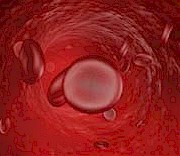Swelling (inflammation) is your body's natural reaction to an injury. Inflammation can happen anywhere—on the skin, within the body, and even inside the arteries. In fact, scientists are now learning that inflammation may play a part in many of the diseases that come with aging, including coronary artery disease.
What is vulnerable plaque?
For many years, doctors have thought that the main cause of a heart attack or stroke was the buildup of fatty plaque within an artery leading to the heart or brain. With time, the plaque buildup would narrow the artery so much that the artery would either close off or become clogged by a blood clot (much like a clogged drain). The lack of oxygen-rich blood to the heart would then lead to a heart attack. But these types of blockages cause only about 3 out of 10 heart attacks.
Researchers are now finding that many people who have heart attacks do not have arteries severely narrowed by plaque. In fact, vulnerable plaque may be buried inside the artery wall and may not always bulge out and block the blood flow through the artery. This is why researchers began to look at how inflammation affects the arteries, and if inflammation could lead to a heart attack. What they found was that inflammation leads to the development of "soft" or vulnerable plaque. They also found that vulnerable plaque was more than just debris that clogs an artery, but that it was filled with different cell types that help with blood clotting.
What causes vulnerable plaque?
Researchers now think that vulnerable plaque is formed in the following way.
- Fat droplets are absorbed by the artery, which causes the release of proteins (called cytokines) that lead to inflammation.
- The cytokines make the artery wall sticky, which attracts immune-system cells (called monocytes).
- The monocytes squeeze into the artery wall. Once inside, they turn into cells called macrophages and begin to soak up fat droplets.
- The fat-filled cells form a plaque with a thin covering.
When this inflammation is combined with other stresses, such as high blood pressure, it can cause the thin covering over the plaque to crack and bleed, spilling the contents of the vulnerable plaque into the bloodstream. The sticky cytokines on the artery wall capture blood cells (mainly platelets) that rush to the site of injury. When these cells clump together, they can form a clot large enough to block the artery.
How is vulnerable plaque detected?
Patients with this kind of plaque may not feel symptoms. In the early stages of the process, the change in blood flow may not be detected with standard testing, but researchers are looking at special scanning techniques that may highlight the presence of vulnerable plaque.
Cardiologists have found that by measuring the level of a substance called C-reactive protein in the bloodstream, they can predict a person's risk of heart attack or stroke. C-reactive protein is a marker that doctors use to measure inflammation activity in the body. Two large studies showed that the higher the C-reactive protein levels in the blood, the greater the risk of a heart attack.
Not all vulnerable plaque ruptures, and researchers at the Texas Heart Institute are looking at ways to determine which vulnerable plaques are most likely to rupture. Some of our researchers are measuring the temperature of vulnerable plaque. They found that the warmer the plaque, the more likely it will crack or rupture. We are testing catheters that use infrared radiation and metal heat-sensing systems to measure the temperature of vulnerable plaque. Also, scientists at THI have discovered that vulnerable plaque has a low pH (is more acidic) and that such acidic plaques are more likely to rupture. Our researchers are testing a device for the tip of a fiberoptic catheter that will allow them to measure the pH of plaque.
Can vulnerable plaque be prevented?
Patients can lower their C-reactive protein levels in the same ways that they can cut their heart attack risk: take aspirin, eat a proper diet, quit smoking, and begin an exercise program. Researchers also think that obesity and diabetes may be tied to high levels of C-reactive protein. Your doctor can check your C-reactive protein levels with a blood test, and many doctors across the country are adding the test to their patients' cholesterol screening.
Medicines like ACE inhibitors (for treating high blood pressure) and aspirin appear to reduce inflammation in the body, which may prevent heart attacks in people who already have high C-reactive protein levels. Cholesterol-lowering medicines called statins have been found to lower C-reactive protein levels, and doctors are now looking at how these medicines may be used to prevent heart attacks in people with normal cholesterol levels. Doctors are still studying the use of cholesterol-lowering medicines for this purpose.
Recent studies have shown that smoking is very dangerous for people who have vulnerable plaque in their arteries. The nicotine in cigarettes directly affects the inflammatory response, causing the release of more cytokines. Researchers are also studying how your family history and your genes factor into the inflammation process. But most doctors agree that heart-healthy habits still play the most important role in reducing your risk of heart attack.
Updated August 2016



